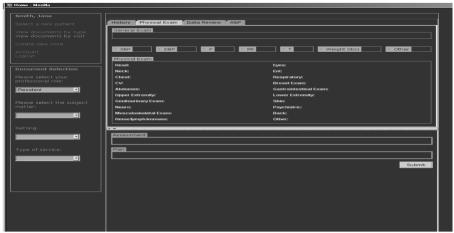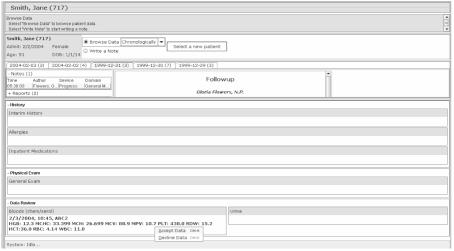Abstract
eNote is an electronic health record (EHR) system based on semi-structured narrative documents. A heuristic evaluation was conducted with a sample of five usability experts. eNote performed highly in: 1)consistency with standards and 2)recognition rather than recall. eNote needs improvement in: 1)help and documentation, 2)aesthetic and minimalist design, 3)error prevention, 4)helping users recognize, diagnosis, and recover from errors, and 5)flexibility and efficiency of use. The heuristic evaluation was an efficient method of evaluating our interface.
Introduction
Tange et al. suggest that the most flexible solution to EHRs is to combine free text with natural language processing (NLP)1. eNote uses document templates to provide clinicians with some structure for data entry, while allowing freedom to express their thoughts using narrative. eNote uses the Health Level 7 (HL7) Clinical Document Architecture (CDA) to structure and markup clinical documents, using XML. NLP extracts and structures information from clinical narratives to create rich, structured clinical notes2.
Background
Heuristic evaluation is a type of usability inspection method. This method evaluates a user interface by inspecting the interface and critiquing the design. In general, heuristic evaluations are easy to conduct, inexpensive and provide feedback quickly.
Methods
Five usability experts were asked to create a new progress note based on the information in a case study and to assess eNote using a heuristic evaluation tool. For each of Nielsen’s usability heuristics3, there were several sub-questions for the evaluator to complete. Each sub-question had a corresponding severity rating, bringing the total number of questions to 118. Usability experts evaluated whether eNote supported the usability factor by selecting either ‘Yes’ or ‘No’. Scores for each heuristic were created by subtracting the number of usability problems from the total possible usability problems. A higher score means greater usability. Mean usability score is the usability score divided by total number of items.
Results
Highly rated usability factors were: consistency with standards (M=5.1) and recognition rather than recall (M=4.2).
Usability factors requiring improvement were: help and documentation (M=2.5), aesthetic and minimalist design (M=2.4), error prevention (M=1.9), helping users recognize, diagnosis, and recover from errors (M=1.7), and flexibility and efficiency of use (M=1.5).
Conclusion
The majority of the findings have challenged this team to create a better, more user-centered interface. After redesigning the interface, we will conduct usability test with actual end-users. This may provide insight into how eNote can improve clinicians’ workflow processes in the health care environment.
Figure 1.
eNote interface before the heuristic evaluation
Figure 2.
eNote interface after the heuristic evaluation
Acknowledgments
Supported by 1R01 LM 07268 and T15 LM007079.
References
- 1.Tange HJ, Hasman A, de Vries Robbe PF, Schouten HC. Medical narratives in electronic medical records. Int J Med Inform. 1997;46(1):7–29. doi: 10.1016/s1386-5056(97)00048-8. [DOI] [PubMed] [Google Scholar]
- 2.Friedman C, Shagina L, Lussier Y, Hripcsak G. Automated encoding of clinical documents based on natural language processing. J Am Med Inform Assoc. 2004;11(5):392–402. doi: 10.1197/jamia.M1552. [DOI] [PMC free article] [PubMed] [Google Scholar]
- 3.Nielsen J. Ten usability heuristics. [Homepage on the Internet] [cited 2006 Feb 8]. Available from: http://www.useit.com/papers/heuristic/heuristic_list.html.




